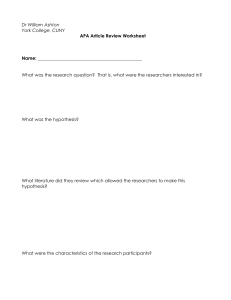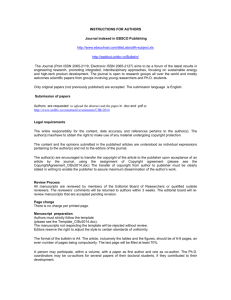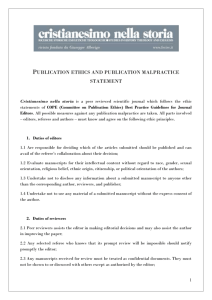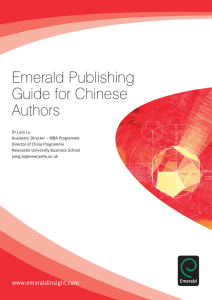Altman-Enhancing
advertisement
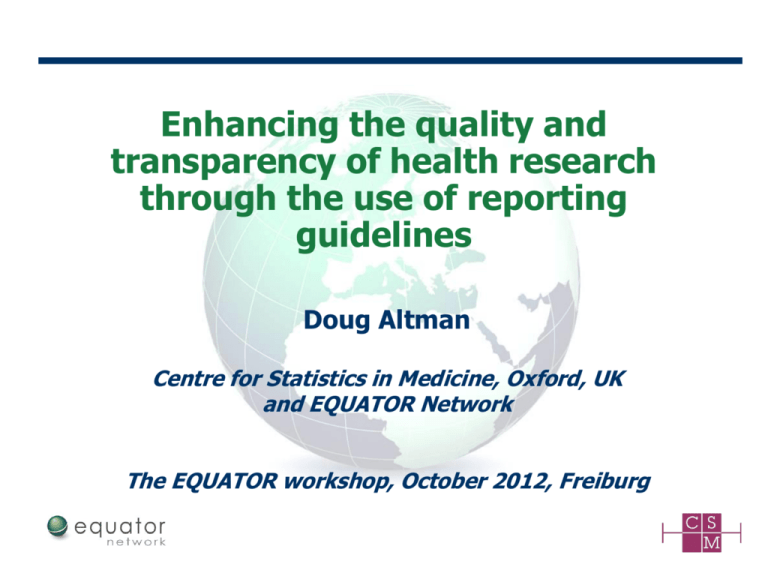
Enhancing the quality and transparency of health research through the use of reporting guidelines Doug Altman Centre for Statistics in Medicine, Oxford, UK and EQUATOR Network The EQUATOR workshop, October 2012, Freiburg The impact of a research article Scientific manuscripts should present sufficient data so that the reader can fully evaluate the information and reach his or her own conclusions about results – to assess reliability and relevance Readers need a clear understanding of exactly what was done – – – – – Clinicians Researchers Systematic reviewers Policy makers … 2 Transparency and value Research only has value if – Study methods have validity – Research findings are published in a usable form 3 What should be reported? “Describe statistical methods with enough detail to enable a knowledgeable reader with access to the original data to verify the reported results.” [International Committee of Medical Journal Editors] A similar principle should extend to all study aspects – Selection of participants, Interventions, Outcomes etc The goal should be transparency – Should not mislead – Should allow replication (in principle) – Can be included in systematic review and meta-analysis 4 What do we mean by poor reporting? Mainly Key information is missing, incomplete or ambiguous – Methods – Results Also Selective reporting – Whole or part of study Misleading interpretation etc 5 Evidence of poor reporting There is considerable evidence that many published articles omit vital information – Hundreds of reviews of published research articles We often cannot tell exactly how the research was done 6 Reports of RCTs indexed on PubMed 7 7 Reporting of research “In 37% of papers patient numbers were inadequately reported; 20% of papers introduced new statistical methods in the 'results' section not previously reported in the 'methods' section, and 23% of papers reported no measurement of error with the main outcome measure.” [Parsons et al, J Bone Joint Surg Br 2011] 8 Case-control studies Bias in psychiatric case-control studies: literature survey. [Lee et al, Br J Psychiatry 2007] RESULTS “The reporting of methods in the 408 identified papers was generally poor, with basic information about recruitment of participants often absent …” CONCLUSIONS “Poor reporting of recruitment strategies threatens the validity of reported results and reduces the generalisability of studies.” 9 Impact of poor reporting Cumulative published evidence is misleading – Methodological weaknesses may not be apparent – Results may be biased Assessing the reliability of published articles is seriously impeded by inadequate reporting – Clinicians cannot judge whether to use a treatment – Data cannot be included in a systematic review Adverse effects on – Other researchers – Clinicians – Patients 10 Whose fault is poor reporting? Poor reporting indicates a collective failure of authors, peer reviewers, and editors … on a massive scale – What about funders, medical educators, ethics committees, …?? Researchers (authors) may not know what information to include in a report of research Editors may not know what information should be included What help can be given to authors? 11 Reporting guidelines (RG) RG specify a minimum set of items required for a clear and transparent account of what was done and what was found in a research study, reflecting in particular issues that might introduce bias into the research Evidence-based & reflect consensus opinion Benefits of using RG: – Improved accuracy and transparency of publications – Easier appraisal of reports for research quality and relevance – Improved efficiency of literature searching 12 The CONSORT Statement for Reporting RCTs [Schulz et al, JAMA 2010] 25 items which should be reported in the paper – Based on empirical evidence where possible Also a flow diagram describing patient progress through the trial, which should be included in the trial report Most leading general medical journals and many specialist journals have already adopted the CONSORT recommendations – Authors will not be able to hide study inadequacies by omitting important information – transparency 13 Other reporting guidelines Other study types – CONSORT as a model – – – – – – PRISMA (Systematic reviews of RCTs) STARD (diagnostic accuracy studies) STROBE (observational studies) REMARK (tumour marker prognostic studies) … GRIPS (genetic risk prediction studies) Most guidelines are not yet widely supported by medical journals or adhered to by researchers – Their potential impact is blunted 14 15 State of play Not all research is published Research reports are seriously inadequate Improvement over time is slow Reporting guidelines exist for most research types – Have been shown to improve reporting – Endorsement by journals is quite good for CONSORT, not good otherwise – Adherence is not very good – No incentives for researchers to adhere 16 Cobo et al, BMJ 2011 “Additional reviews based on reporting guidelines improve manuscript quality, although the observed effect was smaller than hypothesised and not definitively demonstrated.” 17 What is needed? Authors should be aware of ethical/moral responsibility to publish their findings – Honestly and transparently Authors, editors and peer reviewers should be aware of the needs of readers – Principle of reproducibility – Should be includable in a future systematic review Be aware of, and follow, major reporting guidelines 18 Importance of good research reporting Research reports should present sufficient information to allow a full evaluation of the presented data and further use of these findings Good reporting is an essential part of doing good research 19 20
